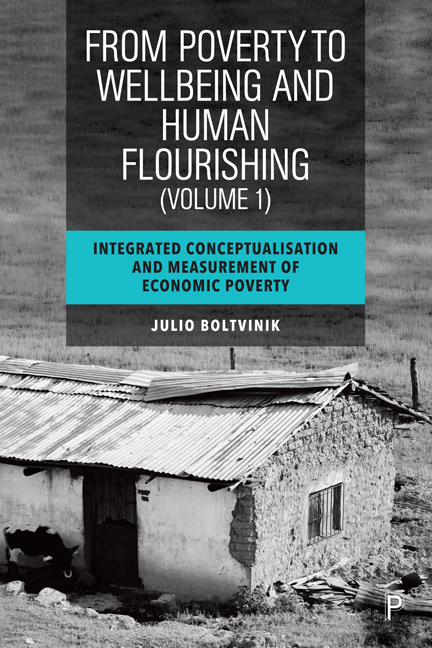 From Poverty to Well-Being and Human Flourishing
From Poverty to Well-Being and Human Flourishing 1 - Households’ reproduction logic, their well-being sources, and concepts of needs and poverty
Published online by Cambridge University Press: 28 March 2024
Summary
In Section 1.1, I present a HH typology and a reproduction scheme (production and circulation) for each type of HH. The reproduction schemes intertwine the three main institutional sectors: households, enterprises, and government. Based on these schemes, Section 1.2 develops the concept of WBS and its role in the critique of partial poverty measurement methods and thus in the development of my own method. Defined WBS are compared with the resource lists of several authors. Section 1.3 introduces the concepts of needs (N) and poverty (P).
1.1 Households’ reproduction schemes and articulation with enterprises and government
As a core part of social organisation, HH carry out the tasks of biological and social reproduction. Keeping current members alive in adequate conditions to perform their social roles, as well as breeding and raising new generations, are the essential social functions of HH. These functions complement those of enterprises (specialised units in the production and marketing of commodities) and the state apparatus, whose main functions can be defined as arbitrating among other social agents and providing public goods and collective services.
Although many HH constitute not only consumption units but also production units, this fact deviates from the ideal model of capitalism, in which all production/marketing is carried out by enterprises, while HH are the sole sphere of consumption. In this model, enterprises establish only two types of relationships with HH: buying their labour force (LF) and selling commodities for consumption. Under conditions of near full employment, the urban reality in the central countries was approaching this ideal model at the end of the 1970s. However, there has been since then a strong trend of enterprise decentralisation, by which many tasks previously performed by salaried personnel in medium-sized and large enterprises are now carried out by independent people or small businesses, regaining the importance of independent individual work and family businesses in urban areas, while in rural areas family businesses never ceased to be important. In peripheral countries, that ideal model has always been far from being achieved, and this has been accentuated by economic stagnation. A significant part of current world’s poverty is associated with non-salaried forms of production.
- Type
- Chapter
- Information
- From Poverty to Well-Being and Human FlourishingIntegrated Conceptualisation and Measurement of Economic Poverty, pp. 13 - 41Publisher: Bristol University PressPrint publication year: 2023


